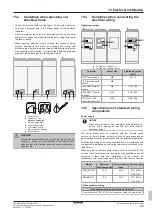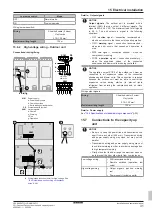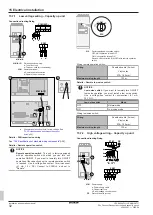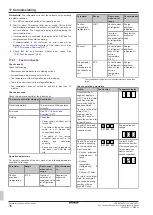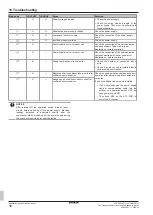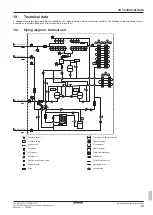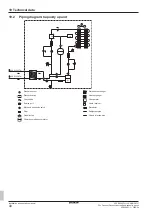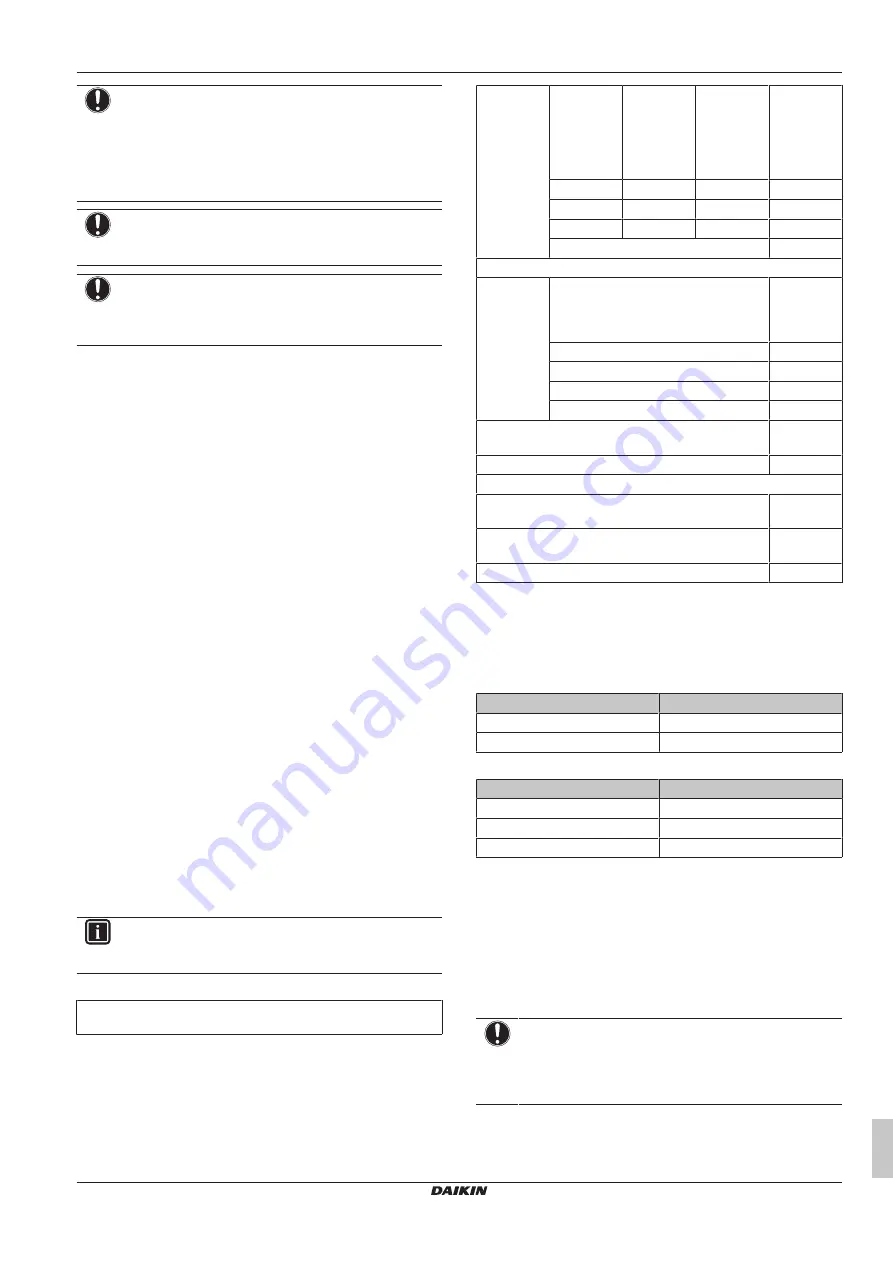
14 Charging refrigerant
Installation and operation manual
25
LRYELRNUN5A7Y1
CO
₂
Conveni-Pack outdoor unit and capacity up unit
4P605461-1 – 2020.04
NOTICE
In case of maintenance and the system (outdoor unit+field
indoor units) does not contain any refrigerant any
more (e.g., after refrigerant reclaim operation), the unit has
to be charged with its original amount of refrigerant (refer
to the nameplate on the unit) and the determined additional
refrigerant amount.
NOTICE
Do NOT fully close the liquid stop valve after the refrigerant
has been charged into the unit.
NOTICE
Do NOT fully close the liquid stop valve while the unit is
stopping. The field liquid piping might burst because of
liquid seal.
14.2
To determine additional refrigerant
amount: method 1
Use method 1 for an outdoor unit WITHOUT a capacity up unit.
1
Calculate each amount of refrigerant for the liquid piping using
the
Calculation table
in this chapter, based on the piping size
and length:
(a) (b)
and
(c)
. You may round off to the nearest
0.1 kg.
2
Total the amounts of refrigerant for the liquid piping:
(a)+(b)+(c)=[1]
3
Calculate the amount of refrigerant for the indoor units using the
Conversion ratio for indoor units: refrigeration
table in this
chapter, based on the type of indoor units and the cooling
capacity:
▪ Calculate the amount of refrigerant for blower coils:
(d)
▪ Calculate the amount of refrigerant for showcases:
(e)
4
Calculate the amount of refrigerant for air conditioner indoor
units using the
Conversion ratio for indoor units: air
conditioners
table in this chapter, based on the model of
indoor units and the number of units connected:
(f)
.
5
Total the amounts of refrigerant for indoor units:
(d)+(e)+(f)=[2]
6
Total the calculated amounts of refrigerant and add the required
amount of refrigerant for outdoor unit:
[1]+[2]+[3]=[4]
7
Charge the total amount of refrigerant
[4]
.
8
If a test runs indicates that additional refrigerant is needed,
charge the additional refrigerant and note down its amount:
[6]
.
9
Total the calculated amount of refrigerant
[4]
, the additional
amount of refrigerant during test run
[6]
, and the factory
charged amount of refrigerant
[5]
(see label on the unit). The
total amount of refrigerant in the system is thus:
[4]+[5]+[6]=[7]
10
Note down the calculation results in the calculation table.
INFORMATION
After charging, add the total amount of refrigerant to the
name plate on the front panel of the unit.
Calculation table: outdoor unit without capacity up unit
Amount of refrigerant for liquid piping (refrigeration / air
conditioner)
Liquid
piping size
Conversion
ratio per
meter of
liquid
piping (kg/
m)
Piping
length (m)
Total
amount of
refrigerant
(kg)
Ø9.5
0.0487
(a)
Ø12.7
0.0858
(b)
Ø15.9
0.1333
(c)
Subtotal (a)+(b)+(c):
[1]
Amount of refrigerant for indoor units
Type of indoor unit
Total
amount of
refrigerant
(kg)
Blower coils
(d)
Showcases
(e)
Air conditioner units
(f)
Subtotal (d)+(e)+(f):
[2]
Required amount of refrigerant for outdoor unit
(kg)
17.0
[3]
Subtotal [1]+[2]+[3] (kg)
[4]
Factory charged amount of refrigerant into
outdoor unit (kg)
6.3
[5]
Additional amount of refrigerant charged when
test run if required (kg)
[6]
Total amount of refrigerant [4]+[5]+[6] (kg)
(a)
[7]
(a)
The maximum amount of additional refrigerant that can be
charged at the time of the test run is 10% of the amount of
refrigerant as calculated from the capacity of connected indoor
units. Use [6]≤[2]×0.1 to calculate this maximum amount.
Conversion ratio for indoor units: refrigeration
Applicable for outdoor unit without capacity up unit.
Type
Conversion ratio
Blower coil
0.062 kg/kW
Showcase
0.309 kg/kW
Conversion ratio for indoor units: air conditioners
Model
Conversion ratio
FXSN50
0.14 kg/unit
FXSN71
0.22 kg/unit
FXSN112
0.34 kg/unit
14.3
To determine additional refrigerant
amount: method 2
Use method 2 for an outdoor unit WITH a capacity up unit.
1
Calculate each amount of refrigerant for the liquid piping using
the
Calculation table
in this chapter, based on the piping size
and length:
(a1) (b1)
(c1)
and
(a2) (b2)
(c2)
. You may round off
to the nearest 0.1 kg.
NOTICE
The conversion ratio for the capacity up unit is different
from the conversion ratio for the outdoor unit. Thus,
calculate the refrigeration side and air conditioner side
separately.
2
Total the amounts of refrigerant for the liquid piping:
(a1)+(b1)+(c1)=[1], (a2)+(b2)+(c2)=[2]
.
Summary of Contents for LRYEN10A7Y1
Page 43: ......



















